Hope is Real
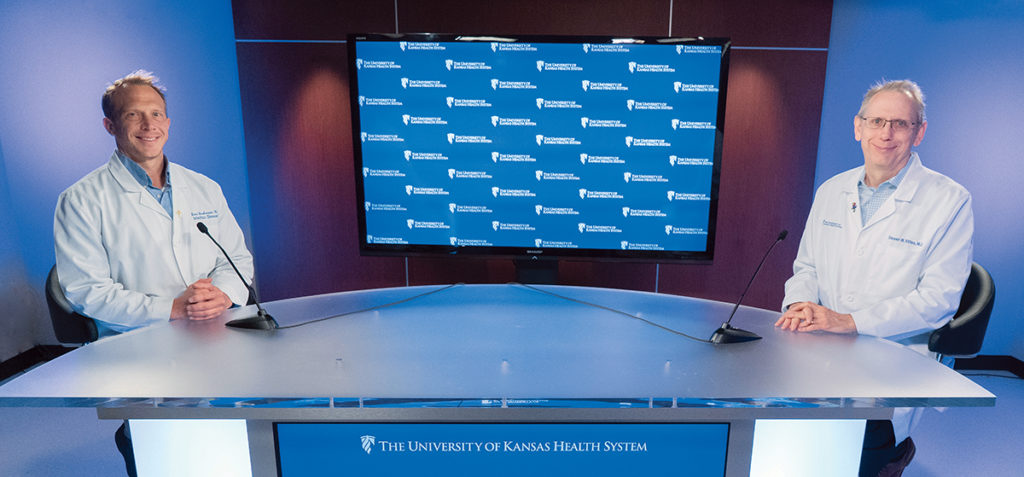
A funny thing happened on the long, painful journey through the pandemic: An unlikely tandem of soft-spoken physicians, all but anonymous outside of KU Medical Center and the University of Kansas Health System, somehow emerged as local celebrities—thanks to their daily “Morning Media Update,” launched in mid-March. Fans laud the docs for what they do and, just as crucially, how they do it.
So when the Royals were finally ready for their long-delayed home opener, on Aug. 1, they chose Dr. Steven Stites to throw out the “virtual first pitch,” with his on-air partner, Dr. Dana Hawkinson, as the catcher. They wore Royals jerseys and caps and slightly goofy smiles, and the pitch-and-catch occurred in front of a computer-generated Kauffman Stadium background. The moment could not have been more appropriate to one crazy summer, when light, cheery, carefree interludes like this were to be savored.
Light, cheery and carefree had hardly been hallmarks of the University of Kansas Health System’s daily COVID-19 updates; even Hawkinson’s April 18 appearance as Jimmy Kimmel’s guest on the “One World: Together at Home” global TV broadcast in support of front-line healthcare workers was hardly a hoot. Yet with Stites and Hawkinson bringing their personalities as well as their expertise to the Kansas City production, the show does its job by purposefully avoiding valueless drama and mean-spirited bickering.
Which, to be certain, have been hallmarks of public discourse in the age of coronavirus.
Instead, Stites and Hawkinson emphasize the basics, over and over, many times on every broadcast, and every broadcast concludes with some variation on Stites’ Aug. 18 summary: “Wear a mask. Keep your distance. Wash your hands. Don’t go out if you’re sick. Cough into your elbow. And please, please, please, stay safe.”
Thanks to their expertise and experience, the doctors deliver daily reminders without sounding preachy, and they elevate “Morning Media Briefing” with long-form interviews—conversations, really—that allow expert, informative and interesting guests the space to explore medical and societal complexities of a global disease that scientists still struggle to understand.
“It’s calming, reassuring, factual,” says FOX 4 anchor John Holt, j’81, l’84. “I’m the journalism and law guy; I don’t understand those science terms. But they make it understandable, and I think they do that for the viewers.”

Episode Zero of the KU hospital’s daily COVID-19 briefing can perhaps be traced to Jan. 23—back when the Chiefs were still a week and a half away from winning the Super Bowl and a weird virus with a funny name was, for most of us in the Western Hemisphere, little more than a vaguely unsettling curiosity wafting through Wuhan.
That’s when Hawkinson, g’00, m’05, medical director of infection prevention and control and associate professor of infectious diseases, sat before a camera in the KU hospital’s state-of-the-art Dolph C. Simons Jr. Family Broadcast Studio and explained a phrase soon to enter the lexicon: “novel coronavirus.”
A hint at what was to come can be gleaned even with the sound off, as Hawkinson, months before he became known as “Doc Hawk” to faithful viewers across the metro area, already appears careworn, as if unsettled by the implications of an evil virus spilling into the world.
“This is all still very fluid and dynamic and so new,” said Hawkinson, explaining that “implications and ramifications” of the novel coronavirus were still, as of late January, unknown. “Who are the real people who are getting ill, or very sick? Are they very young? Are they the very old? What are the demographics of those patients? Because there are so many questions yet, certainly it can be scary.”
The known death toll in China as of that day was 17, and the tally of confirmed U.S. cases was not difficult to chart: one. KU Health System’s next coronavirus video, posted March 4, featured infection prevention nurse Lance Williamson, g’19, explaining why U.S. Surgeon General Jerome Adams on Feb. 29 reacted to a shortage of protective gear by tweeting, “Seriously people—STOP BUYING MASKS!”
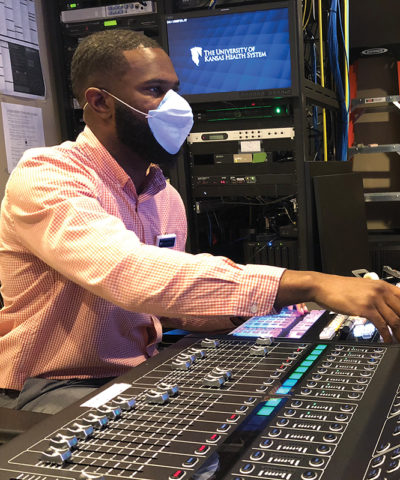
Indeed, when it came time for their first “virtual news conference,” on March 16, the maskless panelists—U.S. Sen. Jerry Moran, c’76, l’82; Tammy Peterman, n’81, g’97, president of the University of Kansas Health System’s Kansas City Division; chief medical officer Dr. Steven Stites; and Dr. Allen Greiner, m’95, g’00, medical officer of Wyandotte County’s Unified Government Health Department—all perched elbow to elbow, close enough to deal cards.
“We look back on that,” Stites says, “and, whaaaaat?”
Even though he now winces at the early gaffe, the outline of a daily conversation that combines expert information with heartfelt compassion was already taking shape: “We’re all in this together,” Stites told his first online audience. The briefing edged closer to its eventual format the next day, when Hawkinson joined Stites on the Simons Studio set. “Together, we can beat coronavirus,” Stites said at the end of the second show, setting the tone of repeating daily aphorisms of positivity. “This. Is. Important: The disease cannot spread if you’re not around people who have it. Stay home. Stay safe.”
Through all the terrifying turns of the pandemic’s early months, across intricate webs of evolving science and fears fueled on social media, Stites looks back and bristles only at their advice on masks; with the rest of it, he’s good.
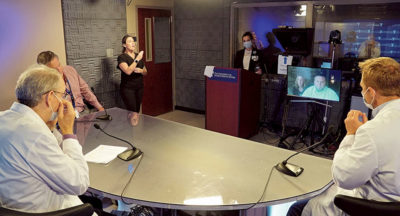
When it comes to dispensing medical and life advice for grappling with COVID-19, aging well, even in the short term, is no trivial accomplishment.
“Really, the only thing we’ve hanged on is the mask use, but that evolved based on the most up-to-date medical knowledge,” Stites says. “Besides that, I think our messages have been consistent, and I think that’s important. Hopefully people understand that and take that to heart.”
In its first five months, the University of Kansas Health System’s daily media briefing attracted a revolving cast of guests, including physicians and researchers from across the hospital and KU Medical Center, health professionals throughout the metro area, politicians, teachers, administrators and others far more too numerous to mention, all engaging in unhurried discussions of every conceivable pandemic-related topic.
Rural health care, telehealth, admittance and outcome trends at regional hospitals, veterans’ medical issues, nursing-home care, sports from youth leagues to the pros, federal funds and personal financial security, children’s mental-health issues, techniques for learning how to embrace face coverings, vaccine development, national and global hotspots, even tips for safe summer travel, as shared by Hawkinson during family road trips. Chancellor Doug Girod made multiple appearances, as did Sen. Moran and Dr. Lee Norman, secretary of the Kansas Department of Health & Environment.
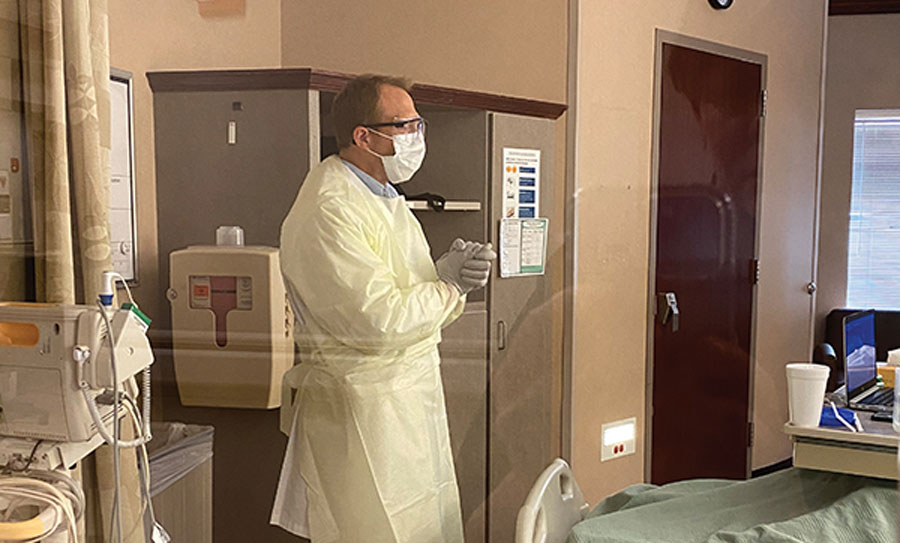
None, though, were more moving than the July 14 visit by COVID-19 survivor Anil Gharmalkar, a powerfully built father of nine from rural Parsons. Gharmalkar, who owns a trucking company, in mid-April hauled a load to Indiana, and on April 18, as he set off for home, became overwhelmed by fatigue. A one-day drive turned into a two-and-a-half-day ordeal; when he finally parked his truck and stumbled into his house, Gharmalkar collapsed onto the couch.
His mother, a traveling nurse, came to check on him, and promptly rushed her critically ill son to the nearest hospital, 20 minutes away. (Gharmalkar shared that his doctors suggested that his mother, wife and children were likely spared viral infection thanks to his bittersweet blessing of enduring the first days of his illness alone in the cab of his truck.) Five days into Gharmalkar’s initial hospitalization, physicians still struggled to boost his dangerously low oxygen levels.
“They decided that they were at the end of their capabilities,” Gharmalkar recalled in a soft, raspy voice. “They gave me an hour to talk to people before they were going to put me on the ventilator. I talked to my wife a little bit, mostly about how to take care of the business while I was gone. I knew the odds were not in my favor, being diabetic and going on a ventilator, and the news wasn’t good everywhere. So I was kind of …”
“A little scared,” Stites injected.
“I was definitely starting to have conversations with God,” Gharmalkar replied, with a reluctant storyteller’s deliberate pace of speech. “I didn’t know if I was coming back … or how long I was going to be. I look back; I wish there were things I would have said to people I care about.”
On April 26, Gharmalkar was life-flighted to the University of Kansas Health System, in Stites’ description, “a very sick man.” So sick, in fact, that Gharmalkar has no memory of the trip. He spent 15 days in intensive care in the KU hospital, including 10 on a ventilator, and returned two months later with a severely swollen throat, which is still being treated with heavy doses of steroids.
Gharmalkar shared that anyone who judges COVID-19 risks only by survival rates overlooks the ordeal required to achieve survival.
“I think there’s a lot of misunderstanding about what recovery means,” he said. “There’s quite a long road back.” Even mild cases can include long-term complications, Gharmalker said, “and I don’t think we really understand what those are just yet. The worst thing you want to be is a guinea pig.”
“It is a story of triumph and survival, but still hardship,” Stites told Gharmalkar. “Thank you. I think you’re helping a lot of people right now.”
“I’m glad I’m still here,” Gharmalkar said, “because of everyone here.”
Steve Stites readily recalls confronting rampant fears surrounding the emergence of HIV/AIDS at the onset of his medical career, in the mid-1980s: “People were pretty afraid that you could get AIDS from all sorts of stuff; there was a lot of controversy about toilet seats and water faucets.” The experience helps inform his desire to educate and reassure, and his gentle demeanor, Stites explains, is not an affectation for the cameras.
“It springs from my worldview; I’m a bit of a rose-colored-glasses guy,” he says, but it also reflects lessons learned in his decades of health care delivery, especially within what he describes as his “specialty niche,” cystic fibrosis.
When he began working with CF patients, Stites says, typical life expectancy was 17 to 19 years; it has since grown to 40-plus. New therapies will eventually allow for “pretty normal” life spans, but real fears remain.
“What I learned over that time is that perhaps hope is more powerful than all the inhaled medicines we have, or all the different therapies for CF.”
What works for cystic fibrosis patients and worried families, Stites contends, applies far beyond clinics, which is not lost on his thousands of regular viewers.
“The KC area is so blessed to be served by KUMC and their health care professionals,” a woman wrote in the live Facebook feed’s always-bustling comments-and-questions thread. “Thanks Drs. Stites and Hawkinson for being present each day and answering question after question, and being humble enough to say they don’t know all the answers. Thank you for keeping us all healthy!”
Media relations director Jill Chadwick, the driving force behind creation of the COVID-19 media briefing, says cards and emails her office receives from members of the community repeatedly stress that the doctors’ hopeful presence “makes them feel calm” and “empowered with knowledge.” One viewer wrote in late July that her children’s schools were demanding to know parents’ preferences, but she wouldn’t make any return-to-school decisions until she heard more from Stites and Hawkinson.
“There are important things that our kids need to go to school for,” Hawkinson says. “This is for their mental and emotional health and their social and physical development, and also for the learning itself. Most parents, myself included, are not good teachers because that’s not what we do every day. We can’t direct our kids to learn in a way that somebody who is not the parent, and who is paid to do that, can.
“For those reasons it certainly is important, but there has to be thoughtful and methodical ways to reduce the risk as much as possible when the kids do go back to school.”
Among many suggestions for “thoughtful and methodical” return to classrooms, Hawkinson points out that parents should be assured that teachers and administrators will avoid staff meetings in small rooms, that every person in the building will wear a mask, and outdoor activities will be emphasized whenever possible.
“It’s easy to look at things that are changing around you and get really discouraged,” Stites says. “Businesses are starting to not do as well or go bankrupt. The numbers are high every day. People, politicians especially, are fighting about stuff, and you’re like, ‘Why are you fighting about this?’ Through all of that, what’s the message that I think is going to be best? It’s the same thing that a patient needs to hear when you visit with them. You’ve got to be honest, you have to tell them the truth, and you have to tell them why there’s some cause for optimism and hope so that they have something to help them hold onto.
“It doesn’t mean you lie. You don’t ever lie. But you can present messages in many different ways, and I think hope is real.”
Talking their way through countless coronavirus issues across the course of the pandemic has, to be sure, impressed upon Stites and Hawkinson the value of communicating effectively. Hawkinson recalls that one of his mentors at the School of Medicine-Wichita, Dr. Kevin Hoppock, m’89, m’92, named the 2015 Kansas Family Physician of the Year, advised him that in order to become “a great doctor,” he must pay close attention when fielding questions from the public.
“Because it’s important to them,” Hawkinson says, “and if it’s important to them, there’s probably a hundred other people who it’s important to as well.”
The ultimate goal, Hawkinson explains, is elegant in its simplicity: Make the good information just as accessible as social media’s flood of bad information.
Armed with that knowledge, we can get through this. Together.
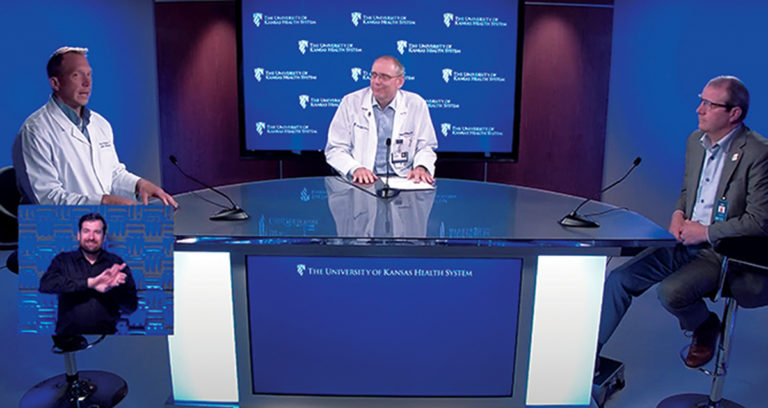
COVID-19 media briefings, which begin at 8 a.m. Monday through Friday and typically last about 45 minutes, can be seen live on the University of Kansas Health System’s Facebook page, @kuhospital; public comments and questions are encouraged. The complete archive can be found at medicalnewsnetwork.org/newsnetwork/doctalk.